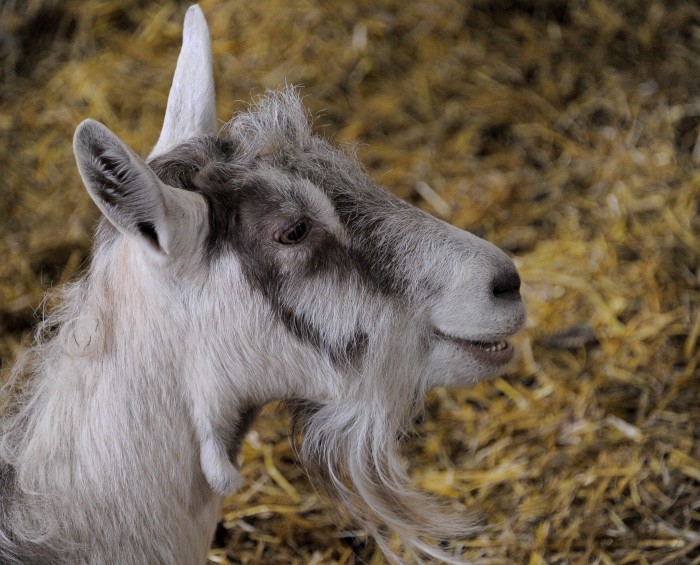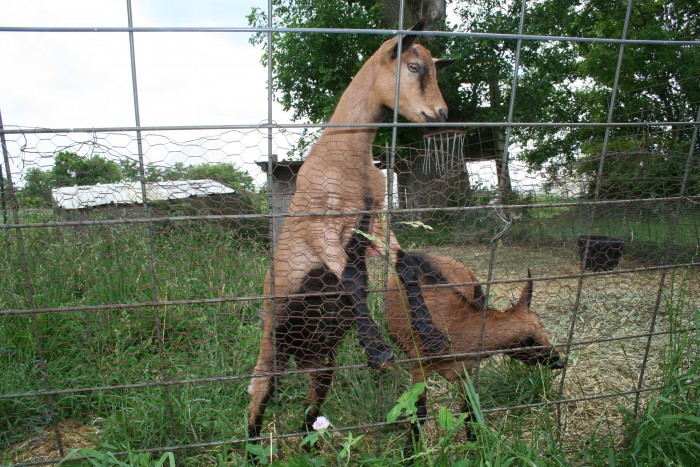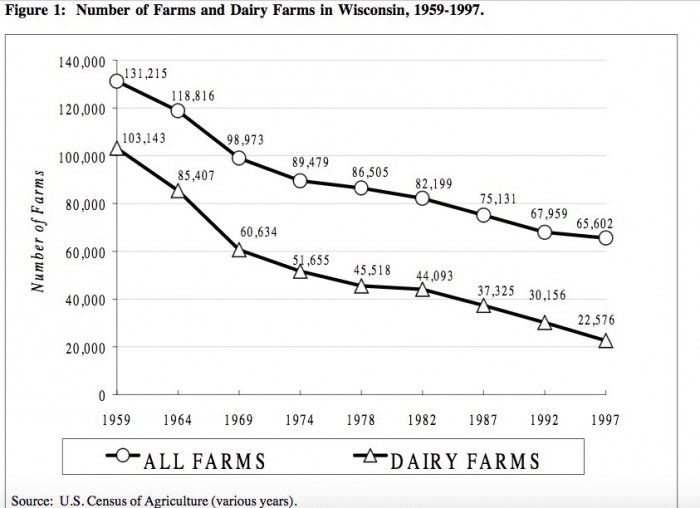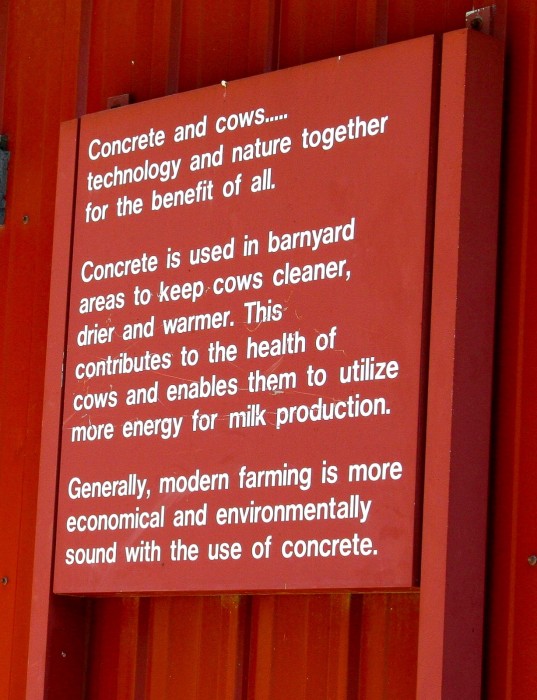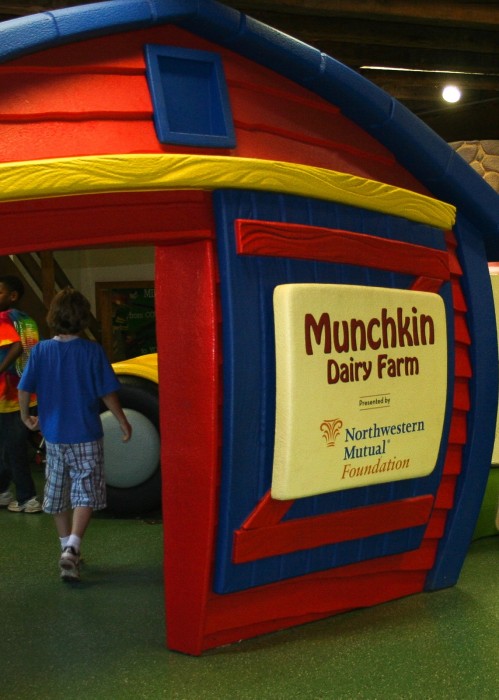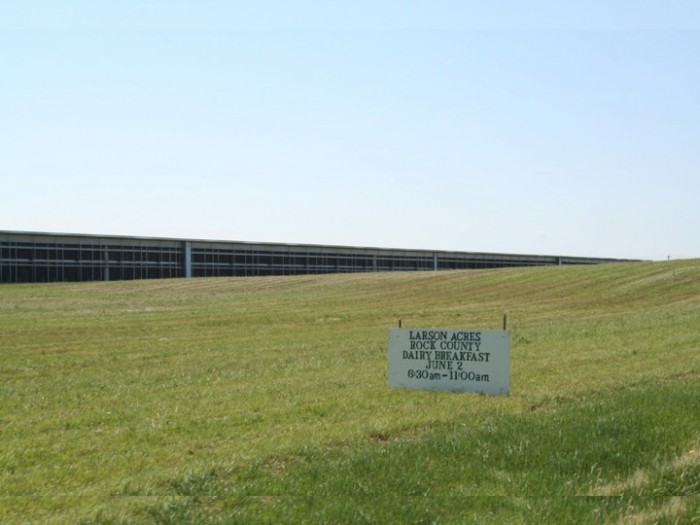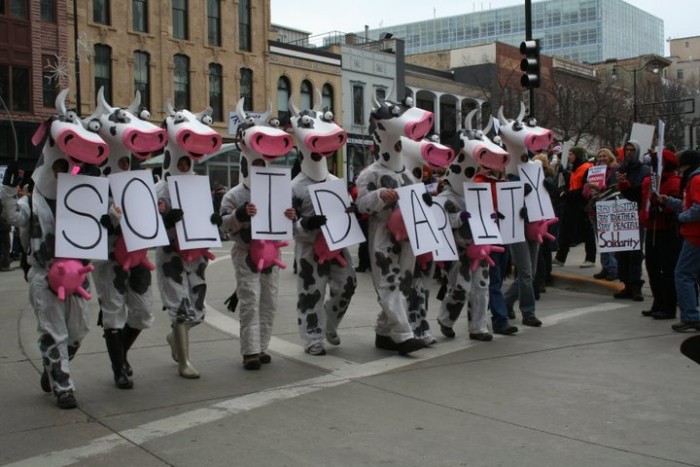One February day, I visited organic farmers Liz and Mike Lane in their southwestern Wisconsin farmhouse. Wounded old cats wandered around in the yard, where goats stuck their muzzles through slats in the fence. The clapboard farmhouse was not as neat as a pin. Seed catalogs, seed packets, CSA sign-up sheets, tax documents and forms, and piles of newspapers, books, and almanacs covered every surface of the dining room. The couple looked exhausted. We settled in the living room and they told me about the CAFO that had moved in around the corner.
CAFOs are concentrated animal feeding operations, barns housing 1,000 to 10,000 cows raised for dairy or beef. In The Omnivore’s Dilemma, Michael Pollan (2006) describes these as corporate farms that pollute ground water by concentrating manure, breed new strains of E. coli, and visit unspeakable horrors and cruelties on their bovine inhabitants. California’s milk production outpaces Wisconsin’s, and most of it comes from just 1,500 farms, virtually all CAFOs. In contrast, Wisconsin is unique for its many small farms and dairies; CAFOS are a relatively new phenomenon. However, for decades small farms have been declining in numbers and increasing in scale and productivity. In 1959, all of Wisconsin’s milk was produced on 103,000 small dairies. By the 1970s, the number of dairies had decreased by half; and by the 1990s by half again, In 2017, 9,406 small dairy farms—many with fewer than 100 cows each—produced about 79 percent of the state’s milk. The remaining nineteen percent of the milk was produced on approximately 250 dairy CAFOs (WI DNR 2017; WMMB 2017).
Source: Jackson-Smith and Barham 2000.
Many of these CAFOS have been built since 2006, when a state law abrogated the right of communities to prohibit permits to such concentrated operations. Local criteria, such as water pollution regulations, were often more stringent than state ones. Since Larson Acres started its nearby CAFO, Mike and Liz Lane have suffered headaches and other ailments caused by nitrogen contamination in the well water. They have lost many goats to miscarriage, also a result of nitrogen poisoning, which reduces the amount of oxygen available in the blood. Even worse, they feel that the CAFO undermines the diversified smallholder rural economy. Rural areas dominated by CAFOs and other industrial agricultural operations tend to be depopulated. The few workers required by these operations are usually immigrants who are paid too little to support ancillary service economies in nearby towns. Many CAFO laborers come to Wisconsin on H2A visas or as undocumented workers—in both cases, they have no citizenship rights (Harrison et al 2009). The CAFO landscape is not only polluted but also undemocratic. It is the landscape of oligarchy described by Wendell Berry (1977: 41), the guru of sustainable organic farming:
I remember, during the fifties, the outrage with which our political leaders spoke of the forced removal of the populations of villages in communist countries. I also remember that at the same time, in Washington, the word on farming was ‘Get big or get out’—a policy which is still in effect and which has taken an enormous toll. The only difference is that of the method: the force used by the communists was military; with us it has been economic—a ‘free market’ in which the freest were the richest . . . And so those who could not get big have got out . . . But as a social or economic goal, bigness is totalitarian; it establishes an inevitable tendency toward the one that will be the biggest of all.
The removal of peasant villages in the Soviet Union and the reorganization of labor within large-scale industrial farms were known as forced collectivization, a state project that merited a chapter in James Scott’s (1998) Seeing Like a State. Collective agriculture was an attempt to develop economies of scale in agriculture, and as Scott points out, was modeled on the large farms of the US Midwest. It corresponded to a particular state vision of modernity and to a theory of statecraft that linked power with the simplification of complex, local knowledge, and the triumph over natural ecological impediments to standardization. These are the hallmarks of modern agriculture.
Dairy CAFOs have developed out of long-standing modernist-scientific conceptions of hygienic production promoted by land grant universities that, as Melanie Dupuis (2002) showed in Nature’s Perfect Food, began to promote the professionalization and mechanization of milk production as early as the 1920s. The story of proper scientific milk production is on display at the Milwaukee County Zoo, where an informational placard asserts that cement is more hygienic and comfortable for cows than grass, and where a reproduction of a milking parlor shows off the mechanical milking process. In this exhibit, a transparent milk cow is displayed as though she is a machine. In Wisconsin, milk and dairy are traditional symbols of economic prosperity connected to farm life, and farm life is naturalized in its legible and mechanical form. But the shape and form that farm life has taken on over the decades is very much a product of statecraft. Food policy has built a standardized agriculture that produces vast quantities of subsidized commodities. These commodities, in turn, subsidize underpaid urban workers, serve as a foreign policy weapon in the form of food aid, and, when sold cheaply on the global market, topple rival agricultural economies. Increasingly, concentrated food corporations such as Conagra, Archer Daniels Midland, Cargill, and, in the case of milk, Dean control most of the food distribution and demand the concentration of production.
***
Michael Pollan’s account of the alienation of rural life raises the specter of a corporate villain. But the story is more complex than that. Neither the values of industrial agriculture nor its massive scale originated entirely outside of the family farm system, or entirely outside rural values.
On that February day in Wisconsin, Mike and Liz Lane told me the story of Larson Acres, the family farm around the corner. Mike was one of the plaintiffs in a case against this neighbor that eventually made it to the Wisconsin Supreme Court, which ruled against him in May 2014. In litigation for years, his case challenged the right of the State of Wisconsin to supersede local zoning ordinances. Larson Acres is a venerable family farm that has been in continuous operation for nearly a century. The Larson family is a pillar of the community and speaks for many people who live there, and the majority of people who practice conventional agriculture of various kinds. Mike described the farm to me this way:
About 85 years ago, the Larson family moved to this area and started farming. About every 10 years, there’s a severe economic crunch that forces a lot of farms out of business. And every time this happened, the patriarch in this family would buy up farms that were in trouble. Over a period of 85 years, they bought up half the township’s land or rented it. They own or rent almost half of the land in the township just north of us. About 15 years ago, they started increasing the size of their dairy farm. [About 10 years ago,] a 440-acre dairy farm went bankrupt and the Larsons bought that farm, and then they tore down an almost brand new barn and built a quarter-mile-long calving operation and consolidated five farms’ production into one.
This was the beginning of the Larson Acres CAFO. Initially, it began its operations without permits and continued to operate in violation of a cease and desist order from the township, which allowed only one cow or one horse per acre of land. With soil depths of only six inches and limestone karst geology that allows manure from holding lagoons to sink directly into the groundwater, too many cows translates into serious pollution. In the case of the Larsons, lawyers, connections, and lots of money eventually won them a variance to the local zoning laws. But in this period, when most communities around the state were refusing CAFO permits, CAFO owners and the National Dairy Council (which farmer Mike refers to as the lobbying organ for Dean Foods) began to pressure the state to do something about local ordinances. The immediate catalyst for passing the new law was a conflict in a rural community that turned ugly when a poor farmer took out a $500,000 loan to open a hog CAFO. This would have been a contract farm, where the meat packer guaranteed the loan and the producer would make a small salary. The scheme appealed to the farmer, Mike told me, because he would be able to hire laborers. Working alone, he had never been free even to attend one of his son’s high school basketball games. When the township denied him a permit, the farmer felt his right to use his property as he saw fit had been violated. The state argued that it would be the best mediator between community mandates and individual rights, and subsequently set up a special committee to review CAFO permits.
The Jeffersonian ideal of the smallholding farmer citizen is invoked both to reject CAFOs and to defend them. Whereas Mike Lane saw sustainable organic farming by families as the expression of Jeffersonian democracy, the hog farmer believed that democracy meant that he had the right to use his property as he saw fit, regardless of the effects on his neighbors. Mike was careful to point out that CAFOs were generally family operations. Referring to the Larsons, he explained:
These families—and they are families, they are hardworking people, and they are very aggressive people. And they’re good business people. And that is all they see. It’s the bottom line and the business and the money and the profit. And their legacy is their family. Not the legacy of the community. Whereas for us, the legacy is the whole world. For us, we give our whole lives to sustainability and organic agriculture. And it’s never been about just us or even just our family.
Many small farmers know that farm policy is not reducible to private property rights and that there is more at stake here than the family. As Tony Ends told me in reference to his failed Supreme Court challenge:
When somebody takes on an issue like this, it’s not for the faint of heart. And you have to go into it knowing that you’re likely to lose. You do it for dignity and because to be human is to live as if there’s hope, even if there isn’t hope. What Wendell Barry said was, ‘We can’t delude ourselves; there is absolutely no reason to have any hope in the food and farming system. The way we’re going, the power that’s lined up against us, it’s a hopeless situation. But to be human is to live as if there’s hope and that’s what we have to do.’
Molly Doane is Associate Professor of anthropology and Affiliated Associate Professor of Latin American and Latino studies at the University of Illinois at Chicago. Her research concerns environmental politics, alternative markets, and social movements in Mexico and the United States. Her book Stealing Shining Rivers: Agrarian Conflict, Market Logic, and Conservation in a Mexican Forest won a 2012 “best book” award from the Latin American Studies Association. Her research has been supported by the National Science Foundation and the Wenner-Gren Foundation for Anthropological Research. She is co-editor of the book series Critical Green Engagements: Investigating the Green Economy and Its Alternatives, published by the University of Arizona Press.
References
Berry, Wendell. 1977. The Unsettling of America: Culture and Agriculture. San Francisco: Sierra Club Books.
Dupuis, Melanie. 2002. Nature’s Perfect Food: How Milk Became America’s Drink. New York: New York University Press.
Harrison, Jill, Sarah Lloyd, and Trish O’Kane. “Overview of immigrant workers on Wisconsin dairy farms.” Program on Agricultural Technology Studies (2009).
Jackson-Smith, Douglas and Bradford Barham. 2000. The Changing Face of Wisconsin Dairy Farms: A Summary of PATS Research on Structural Change in the 1990s. PATS Research Report No. 7. Madison: Program on Agricultural Technology Studies, University of Wisconsin–Madison. http://www.pats.wisc.edu/pubs/39.
Pollan, Michael. 2006. The Omnivore’s Dilemma: A Natural History of Four Meals. New York: Penguin.
Scott, James. 1998. Seeing Like a State: How Certain Schemes to Improve the Human Condition Have Failed. New Haven, CT: Yale University Press.
WI DNR (Wisconsin Department of Natural Resources). 2017. “CAFOs with EPDES Permits.” http://dnr.wi.gov/topic/AgBusiness/documents/cafograph_lg.pdf (accessed 3 July 2017).
WMMB (Wisconsin Milk Marketing Board). 2017. 2017 Dairy Data: A Review of the Wisconsin Dairy Industry. Madison: WMMB. http://www.wmmb.com/assets/images/pdf/WisconsinDairyData.pdf.
Cite as: Doane, Molly. 2017. “To Be Human Is to Live as if There Is Hope.” EnviroSociety, 3 July. www.envirosociety.org/2017/07/to-be-human-is-to-live-as-if-there-is-hope.
